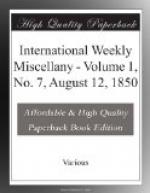“Whenever you are at Esher,” said the devoted daughter, the last time we conversed with her, “do visit my mother’s tomb.” We did so. A cypress flourishes at the head of the grave; and the following touching inscription is carved on the stone:—
Here sleeps in Jesus a Christian widow, JANE PORTER. Obiit June 18th, 1831, aetat. 86; the beloved mother of W. Porter, M.D., of Sir Robert Ker Porter, and of Jane and Anna Maria Porter, who mourn in hope, humbly trusting to be born again with her unto the blessed kingdom of their Lord and Savior. Respect her grave, for she ministered to the poor.
* * * * *
RECENT DEATHS.
* * * * *
MR. KIRBY, THE ENTOMOLOGIST.
The Rev. William Kirby, Rector of Barham, Suffolk, who died on the 4th ult. in the ninety-first year of his age, with his faculties little impaired, ranked as the father of Entomology in England; and to the successful results of his labors may he chiefly attributed the advance which has been made in this over other kindred departments of natural history. His reputation is based not so much on the discoveries made by him in the science as on the manner of its teaching. No man ever approached the study of the works of nature with a purer or more earnest zeal. His interpretation of the distinguishing characters of insects for the purposes of classification has excited the warmest approval of entomologists at home and abroad; while his agreeable narrative of their wonderful transformations and habits, teeming with analyses and anecdote, has a charm for almost every kind of reader.
Mr. Kirby’s first work of particular note was the “Monographia Apum Angliae”, in two volumes published half a century ago at Ipswich; to which town he was much endeared, and in whose Museum, as President, under the friendly auspices of its Secretary, Mr. George Ransome, he took a lively interest. His admirable work on the Wild Bees of Great Britain was composed from materials collected almost entirely by himself,—and most of the plates were of his etching. Entomology was at that time a comparatively new science in this country, and it is an honorable proof of the correctness of the author’s views that they are still acknowledged to be genuine.
His further progress in entomology is abundantly marked by various papers in the “Transactions of the Linnaean Society",—by the entomological portion of the Bridgewater Treatise “On the History, Habits, and Instincts of Animals,”—and by his descriptions, occupying a quarto volume, of the insects of Sir John Richardson’s “Fauna Boreali-Americana.” The name of Kirby will, however, be chiefly remembered for the “Introduction on Entomology” written by him in conjunction with Mr. Spence. In this work a vast amount of material, acquired after many years’ unremitting observation of the insect world, is mingled together




